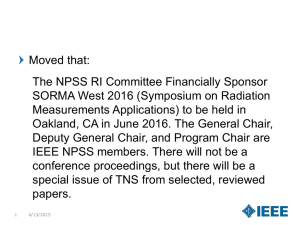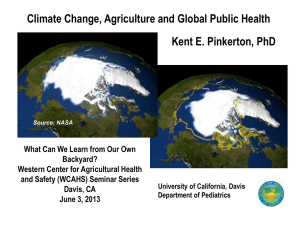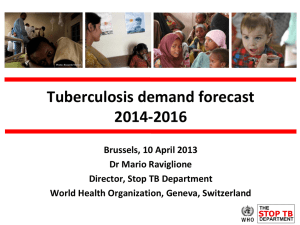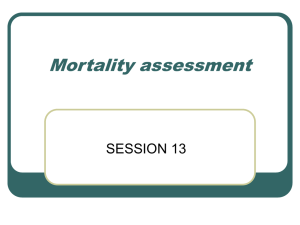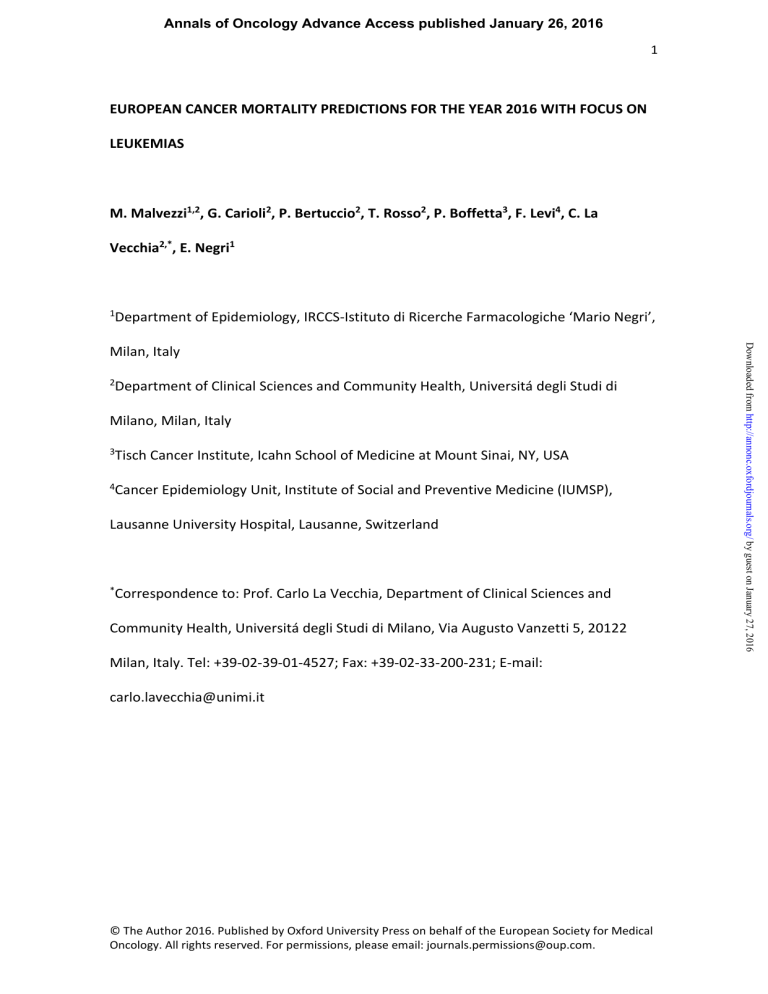
Annals of Oncology Advance Access published January 26, 2016
1
EUROPEAN CANCER MORTALITY PREDICTIONS FOR THE YEAR 2016 WITH FOCUS ON
LEUKEMIAS
M. Malvezzi1,2, G. Carioli2, P. Bertuccio2, T. Rosso2, P. Boffetta3, F. Levi4, C. La
Vecchia2,*, E. Negri1
1
Department of Epidemiology, IRCCS-Istituto di Ricerche Farmacologiche ‘Mario Negri’,
2
Department of Clinical Sciences and Community Health, Universitá degli Studi di
Milano, Milan, Italy
3
Tisch Cancer Institute, Icahn School of Medicine at Mount Sinai, NY, USA
4
Cancer Epidemiology Unit, Institute of Social and Preventive Medicine (IUMSP),
Lausanne University Hospital, Lausanne, Switzerland
*
Correspondence to: Prof. Carlo La Vecchia, Department of Clinical Sciences and
Community Health, Universitá degli Studi di Milano, Via Augusto Vanzetti 5, 20122
Milan, Italy. Tel: +39-02-39-01-4527; Fax: +39-02-33-200-231; E-mail:
carlo.lavecchia@unimi.it
© The Author 2016. Published by Oxford University Press on behalf of the European Society for Medical
Oncology. All rights reserved. For permissions, please email: journals.permissions@oup.com.
Downloaded from http://annonc.oxfordjournals.org/ by guest on January 27, 2016
Milan, Italy
2
ABSTRACT
Background: Current cancer mortality statistics are important for public health
decision making and resource allocation. Age standardized rates and numbers of
deaths are predicted for 2016 in the European Union.
Patients and methods: Population and death certification data for stomach,
obtained from the World Health Organisation database and Eurostat. Figures were
derived for the EU, France, Germany, Italy, Poland, Spain and the UK. Projected
numbers of deaths by age group were obtained for 2016 by linear regression on
estimated numbers of deaths over the most recent time period identified by a
joinpoint regression model.
Results: Projected total cancer mortality trends for 2016 in the EU are favourable in
both sexes with rates of 133.5/100,000 men and 85.2/100,000 women (8% and 3%
falls since 2011, due to population ageing) corresponding to 753,600 and 605,900
deaths in men and women for a total number of 1,359,500 projected cancer deaths
(+3% compared to 2011). In men lung, colorectal and prostate cancer fell 11%, 5% and
8% since 2011. Breast and colorectal cancer trends in women are favourable (8% and
7% falls, respectively), but lung and Pancreatic cancer rates rose 5% and 4% since 2011
reaching rates of 14.4 and 5.6/100,000 women. Leukemia shows favourable projected
mortality for both sexes and all age groups with stronger falls in the younger age
Downloaded from http://annonc.oxfordjournals.org/ by guest on January 27, 2016
colorectum, pancreas, lung, breast, uterus, prostate, leukemia and total cancers were
3
groups, rates are 4.0/100,000 men and 2.5/100,000 women, with respectively falls of
14% and 12%.
Conclusion:The 2016 predictions for EU cancer mortality confirm the favourable trends
in rates particularly for men. Lung cancer is likely to remain the leading site for female
cancer rates. Continuing falls in mortality, larger in children and young adults, are
predicted in leukemia, essentially due to advancements in management and therapy,
and their subsequent adoption across Europe.
Key Message: "Total cancer mortality rates in the EU are predicted to fall 8% in men and 3% in
women between 2011 and 2016. However, due to population aging, total number of cancer
deaths will rise to 1,360,000. Mortality outlook for 2016 remains favourable, except for lung
and pancreatic cancers in women. Leukemias showed favourable trends in both sexes and all
age groups, with larger falls in the young."
Downloaded from http://annonc.oxfordjournals.org/ by guest on January 27, 2016
Keywords: cancer, Europe, mortality, projections, leukemia, time trends.
4
INTRODUCTION
We previously published short-term cancer mortality predictions for the European
Union (EU) as a whole, and for its six more populous countries up to the year 2015 [15]. On the basis of the World Health Organization (WHO) mortality database [6], here
we provide the corresponding figures for the year 2016. In the present paper, we also
focus specifically on leukemias, giving predicted numbers of deaths and death rate
estimates for this important group of neoplasms in various age groups, and discuss
MATERIALS AND METHODS
This work is an update to the previous articles on predicted European cancer mortality,
hence similar methods are used [1, 5].
We obtained official death certification data from the WHO database (WHOSIS) [6] for
stomach, colorectum, pancreas, lung, breast, uterus (cervix and corpus), prostate,
leukemias and total cancer (malignant and benign) mortality.
Figures were derived for the EU (28 countries as of July 2013) in the period 1970-2011
and up to the most recent available year for 6 major European countries: France
(2011), Germany (2013), Italy (2012), Poland (2013), Spain (2013) and the UK (2013).
Details on data sources and preparation are given in the Appendix.
From the matrices of certified deaths and resident populations, we computed agespecific number of deaths and rates for each 5-year age group (from 0–4 to 85+ years)
and calendar year. Age-standardised rates (world standard population) per 100 000
men and women, at all ages, were computed using the direct method, on the basis of
Downloaded from http://annonc.oxfordjournals.org/ by guest on January 27, 2016
their declines across sexes, countries and age groups.
5
the world standard population [7]. For leukemias, rates for the 0-14, 15-44 and 45-69
years age-groups were also computed.
We fit a logarithmic Poisson count data joinpoint regression model to the numbers of
certified deaths for each 5-year age group to identify the most recent trend segment
(see Appendix) [8].
We applied a linear regression to mortality data for each 5-year age group over the
most recent trend segment identified by the joinpoint model in order to compute the
prediction intervals (PIs) [9]. Predicted age-specific numbers of deaths and the
predicted population data from Eurostat were used to compute the predicted age
standardized death rates with 95% PIs [10].
RESULTS
Table 1 shows the total numbers of predicted cancer deaths (rounded to the nearest
hundred) and the death rate predictions with corresponding 95% PIs for the selected
neoplasm for 2016, in the EU as a whole, as well as the 2011 recorded data. Overall, 1
359 500 EU citizen are projected to die of cancer in 2016 (753 600 men and 605 900
women), compared with the 1 314 787 cancer deaths recorded in 2011 (734 259 men
and 580 528 women). These figures correspond to age-standardised rates of 133.5/100
000 men and 85.2/100 000 women predicted for 2016, compared with 144.6 men and
88.1 women recorded in 2011. Thus, a 7.7% fall in rates for men and a 3.3% one in
women are predicted between 2011 and 2016, despite an increase of about 45 000
(+3.3%) in the absolute number of cancer deaths.
Downloaded from http://annonc.oxfordjournals.org/ by guest on January 27, 2016
predicted age-specific certified numbers of deaths and the corresponding 95%
6
Figure 1A shows bar plots of death rates per 100 000 population and numbers of
deaths from all cancers for the year 2011 for EU men and women, and the predicted
values for 2016 with corresponding 95% PIs. Figure 1B shows bar plots of death rates
per 100 000 population for 2011 and the predicted rates for 2016 with 95% PIs for the
eight neoplasm sites considered for the EU (in men and women).
Lung cancer is responsible for nearly 274 000 predicted deaths in both sexes combined
in 2016, corresponding to over 20% of total cancer deaths, and it has the highest
predicted deaths (24.4% of total male cancer deaths), despite a 10.7% fall in rates
since 2011. In women, mortality from lung cancer is still rising and it is likely to be the
neoplasm with the highest mortality rate in the EU in women in 2016, with a predicted
rate of 14.4/100 000, corresponding to 89 700 predicted deaths (14.8% of total female
cancer deaths), and to a 5.4% rise in rates since 2011.
Breast cancer has the second highest projected rate (14.3/100 000, with a 7.6% fall
from 2011), but the total number of deaths remains highest for this neoplasm (92
300). Between the ages of 55 and 79 years, more deaths from female lung than breast
cancer were predicted, while in elderly women an excess in breast cancer deaths
persisted.
The cancer with the second largest impact in men is that of colorectum, with a
predicted rate of 16.2/100 000 corresponding to a 4.6% fall, followed by prostate
cancer, with a predicted rate of 10.6/100 000 men with a 7.8% fall since 2011. In
women colorectal cancer shows the third highest predicted rate (9.3/100 000, with a
Downloaded from http://annonc.oxfordjournals.org/ by guest on January 27, 2016
predicted rates in both sexes, in men 34.0/100 000, corresponding to 183 800
7
7.0% fall from 2011); deaths from this cancer represent 12.8% of total cancer deaths in
the EU in 2016, with 173 400 projected deaths.
Pancreatic cancer shows rising predicted death rates in women (5.6/100 000, +3.9%),
while the predicted rate of 7.9/100 000 in men only shows a 0.5% fall compared to
2011. The corresponding total deaths are 85 600, that is 6.3% of all predicted cancer
deaths. Cancer of the uterus, stomach and leukemias each represent <5% of total
cancer deaths, and show persistent declines.
women in quinquennia centred from 1972 to 2007, and the predicted rates for 2016
with PIs for all cancers. Trends in total cancer mortality in the EU are favourable in
both sexes; in men rates have been falling since the late 1980s, while in women they
have been favourable over the entire period, though in recent years the falls in women
were less pronounced than in men.
Figure 3 gives corresponding trends for major cancer sites. Stomach cancer mortality
shows the greatest falls over the whole period. In men, lung cancer also showed
appreciable falls in mortality since the late 1980s as did breast cancer in women. The
only exceptions to these generally favourable trends in the EU are pancreatic cancer in
both sexes and lung cancer in women: pancreatic cancer mortality rates have been
showing steady rises in women, while in men it seems to have stabilized. Over the last
decades female lung cancer has shown strong rises. See supplementary Appendix for
individual country data and analyses (supplementary Tables S1–S9 and Figure S1,
available at Annals of Oncology online).
Downloaded from http://annonc.oxfordjournals.org/ by guest on January 27, 2016
Figure 2 illustrates trends in all age standardised cancer mortality rates for men and
8
Table 2 gives age standardised leukemia mortality rates in 2000–2004 and 2005–2009,
predicted mortality rate for 2016 and the percent difference between the 2016
prediction and 2007 (2005-2009 quinquennium), for all ages, 0–14, 15–44 and 45–69
years age groups, for male and female, in the six studied countries and the EU as a
whole. In 2000-2004, leukemia mortality rates for all ages in men were between 5 and
6/100 000, and showed favourable trends in all countries and the EU as a whole, giving
predicted rates for 2016 between 4 (Spain and UK) and 5/100 000 (Poland and Italy).
around 3/100 000, and predicted rates for 2016 are between 2 and 3/100 000 (UK and
Italy). The overall decline between 2007 and 2016 approached 16% in women and 19%
in men. The falls, however were greatest in children (38% in males, 20% in females)
and young adults (26% in males, 22% in females). The predicted rates for 2016 in the
EU are favourable compared with 2011, with values of 4 at all ages, 0.5 at 0–14 years,
1 at 15–44 years and 6.8 /100 000 at 45–69 year in men, and values of 2.5, 0.6, 0.7 and
4.2/100 000 in women, respectively.
Figure 4 illustrates joinpoint analysis of EU leukemia mortality rates for men and
women in the four age groups considered, with predictions for 2016 and relative PIs. In
both sexes, rates for all age groups display a similar pattern with important falls over
the whole studied period, except for men aged 45-69 and all ages, where xxx
favourable trends start in the late 70s.
Downloaded from http://annonc.oxfordjournals.org/ by guest on January 27, 2016
Similarly, in women, in 2000-2004, leukemia mortality rates for all ages in women were
9
DISCUSSION
The 2016 projections confirm the favourable outlook for total cancer mortality
previously reported [3-5]. Total cancer mortality rates in the EU are projected to
decrease in both sexes, in spite of the slight rise in number of deaths due to the ageing
of the European population [11]. In fact, the median age of the total EU population
was 41 in 2011 and rose to 42 in 2016, corresponding median ages for men were 39 in
2011 and 41 in 2016, and in women 42 in 2011 and 44 in 2016. The greater falls seen,
mainly driven by the different trends in cancer related to tobacco smoking between
the sexes [12]. The fall in tobacco related cancer mortality is the main driver for the fall
in overall cancer mortality in men, while in women the fall is mainly due to cancers
amenable to treatment and subject to early diagnosis, i.e. cancers of the breast and
uterus (as well as stomach and colorectum), whereas lung cancer trends remain
upwards [4, 5].
Lung cancer mortality reflects the differences between smoking prevalence trends
between the sexes and European countries [12].
The 2016 projection confirms the steady declines of lung cancer mortality in men and
the increases in women, with lung cancer rates much higher than breast cancer rates
in young and middle age women, indicating that the excess lung cancer mortality is
likely to be greater in the near future. In the UK where female projections for this
cancer have been unstable, updated data to 2013 brought about a downward
projected trend, this would be in line with lung cancer age-period-cohort analyses for
this country [13].
Downloaded from http://annonc.oxfordjournals.org/ by guest on January 27, 2016
over the studied period, in men (over 10%) as compared to women (about 3%), are
10
Improved therapeutic procedures, and advancements in diagnosis and screening have
determined favourable trends in several cancer sites and are among the main drivers
of the decline in cancer mortality in women, including breast and cervical cancer.
However, a slowdown in the falls in uterine cancer mortality is apparent for several
countries. The exception to these descending rates is the UK, particularly in elderly
women and hence likely due to endometrial cancer linked to overweight and diabetes
[14]. National mortality data do not allow separate analysis of cervix and corpus uteri
Prostate cancer trends are also descending, albeit with variable degrees across
countries. The role of screening practices is still debated, but it may have had a role in
the measured and projected falls in mortality.[15, 16]. Effective modern therapies,
including radiotherapy and anti-androgens, and management protocols are, however,
the major determinants of the favourable trends, not only in the middle aged, but also
in the elderly [15]. The excess in mortality for elderly Polish men is likely due to
delayed adoption of these therapies.
EU colorectal cancer mortality reductions are brought mainly by northern and western
European countries thanks to better awareness of the disease, screening, early
diagnosis and patient management protocols and treatments [17, 18]. However,
projected rises in Spain and particularly in Poland (which has the highest rates in
Europe), highlight the need to rationalize these strategies in southern and eastern
Europe.
The favourable trends in mortality from stomach cancer are projected to continue into
2016. Thus, gastric cancer remains one of the main drivers of the total favourable
Downloaded from http://annonc.oxfordjournals.org/ by guest on January 27, 2016
cancers.
11
trends in both sexes; the most probable determinants of these trends are a more
affluent varied diet, better food conservation and the fall in Helicobacter Pylori
infection across generations [19, 20]. However, falls seem to be slowing down,
particularly in women and in countries where rates are already low [20, 21]. This
suggests that mortality levels of this tumour are reaching an asymptote. National
mortality data do not allow to discriminate cardias versus corpus and pyloric cancer. It
is therefore possible that such a levelling in rates is due to lack of declines in cardias
Pancreatic cancer is the tumour with the least favourable outlook in both sexes.
However, in men, projections for the EU give a stable mortality rate rather than a rising
one, while in women the unfavourable trend is confirmed [3-5]. Aetiology for this
cancer is still largely uncertain, but smoking plays a relevant role accounting for 20 to
30% of cases in various populations [22-24]. Consequently, the observed differences in
trends between sexes may well be explained by the different smoking trends. The
other relevant recognized risk factors are obesity and diabetes, whose prevalence has
increased over recent years in most populations [25].
Inferences on leukemia mortality are complicated by the nature of this heterogeneous
group of diseases; national mortality data does not allow for their individual separation
and analysis. Projections for these cancers in 2016 are favourable in both sexes for
most age groups and countries, but the falls are appreciably larger at younger ages.
Therapeutic advancements are the main drivers of these trends; these include better
diagnosis, multidrug chemotherapy and immunotherapy protocols assisted by toxicity
limiting therapies and improved radiotherapy [26, 27].
Downloaded from http://annonc.oxfordjournals.org/ by guest on January 27, 2016
and cardio-esophageal-junction cancer mortality.
12
The distribution of leukemias by type varies by age. Children are generally affected by
acute lymphoblastic leukemia (ALL) that is also frequent in adolescents and young
adults. In contrast chronic leukemias, in particular chronic lymphocytic leukemia (CLL)
is common in the elderly. ALL is mostly curable and 5-year survival in children has
reached over 90% in optimum conditions [28]. Improvements have also been observed
in adolescents and adults; these are attained through improved disease management
and, in recent years, relapse control using allogenic hematopoietic stem cell
adults [29-33]. Stem cell transplants and new chemotherapy regimens have also
brought improvements in acute myelogenous leukemia (AML) that is relatively
common in adult and elderly patients [34, 35]. Chronic leukemia is hardly curable, but
long term survival has been achieved in chronic myeloid leukemia, since the
introduction of tyrosine kinase inhibitors [36-39]. Some improvement in survival in
Europe, though not as strong as in the USA [40], has also been observed in CLL even
though it is mainly in patients under 75 years of age. These improvements are due to
better diagnosis, management and therapy including anti-CD20 antibodies like
Obintuzimab combined with Chlorambucil [41, 42].
Given large size of the underlying population, EU cancer mortality predictions should
not be affected by random oscillations or major unexpected factors. However, if some
factors were to determine changes within the last few years the model would not be
able to account for them. Also the linear models used tend to underestimate future
rates, particularly under certain conditions (eg. asymptotic behaviours after strong
Downloaded from http://annonc.oxfordjournals.org/ by guest on January 27, 2016
transplants and immunotherapy, as well as using pediatric inspired regimens in young
13
descending trends); hence, in some scenarios predictions may be overly optimistic
within a global picture of declining trends [43].
Updated data from the WHO made it possible to compute EU age standardised
mortality rates for 2011, and compare these data with our predictions [1]. All
estimates, with the exceptions, in women, for stomach and uterine cancers and
leukemias, are within a 5% difference. Stomach and uterine cancer trends fall within
the model’s predictive limits, while for leukemia, discrepancy between predicted and
standard population.
In conclusion EU cancer mortality predictions for 2016 confirm the favourable trends in
rates (although in the absence of a decline in the absolute number of deaths)
particularly for men. This is essentially due to larger declines in tobacco smoking in
men than in women in recent decades. Despite the steady favourable trends in breast
and uterine (mainly cervix) cancer mortality, they also confirm that lung cancer is likely
to be the leading site for cancer rates in EU women. With specific reference to
leukemia, they confirm the favourable trends in mortality due to the advancement in
therapy, particularly for acute leukemia in children and young adults.
Downloaded from http://annonc.oxfordjournals.org/ by guest on January 27, 2016
observed rates affects the younger age groups that are weighted heavily in the world
14
REFERENCES
Downloaded from http://annonc.oxfordjournals.org/ by guest on January 27, 2016
1.
Malvezzi M, Arfe A, Bertuccio P et al. European cancer mortality predictions for the
year 2011. Ann Oncol 2011; 22: 947-956.
2.
Malvezzi M, Bertuccio P, Levi F et al. European cancer mortality predictions for the
year 2012. Ann Oncol 2012; 23: 1044-1052.
3.
Malvezzi M, Bertuccio P, Levi F et al. European cancer mortality predictions for the
year 2013. Ann Oncol 2013; 24: 792-800.
4.
Malvezzi M, Bertuccio P, Levi F et al. European cancer mortality predictions for the
year 2014. Ann Oncol 2014; 25: 1650-1656.
5.
Malvezzi M, Bertuccio P, Rosso T et al. European cancer mortality predictions for the
year 2015: does lung cancer have the highest death rate in EU women? Ann Oncol 2015; 26:
779-786.
6.
World Health Organization Statistical Information System. WHO mortality database
Available at: http://www.who.int/healthinfo/statistics/mortality_rawdata/en/index.html 2013
(Last accessed May).
7.
Doll R, Smith PG, Waterhouse JAH et al. Comparison between registries: agestandardized rates. Vol. IV. IARC Sci Publ No. 42. In Cancer Incidence in Five Continents. 1982;
671-675.
8.
Kim HJ, Fay MP, Feuer EJ, Midthune DN. Permutation tests for joinpoint regression
with applications to cancer rates. (Erratum in: Stat Med 2001;20: 655). Stat Med 2000; 19: 335351.
9.
Julian J Faraway. Linear Models with R. Texts in statistical science. vol. 63. Boca
Raton:Chapman & Hall/CRC. 2005.
10.
European Commission. Eurostat population database. In. 2014 (Last access July).
11.
European Commission. Population structure and ageing. In. 2014.
12.
Gallus S, Lugo A, La Vecchia C et al. Pricing Policies And Control of Tobacco in Europe
(PPACTE) project: cross-national comparison of smoking prevalence in 18 European countries.
Eur J Cancer Prev 2014; 23: 177-185.
13.
Bosetti C, Malvezzi M, Rosso T et al. Lung cancer mortality in European women: trends
and predictions. Lung Cancer 2012 78: 171-178.
14.
Parazzini F, La Vecchia C, Negri E et al. Reproductive factors and risk of endometrial
cancer. Am J Obstet Gynecol 1991; 164: 522-527.
15.
Bosetti C, Bertuccio P, Chatenoud L et al. Trends in mortality from urologic cancers in
Europe, 1970-2008. Eur Urol 2011; 60: 1-15.
16.
Cuzick J, Thorat MA, Andriole G et al. Prevention and early detection of prostate
cancer. Lancet Oncol 2014; 15: e484-492.
17.
Ait Ouakrim D, Pizot C, Boniol M et al. Trends in colorectal cancer mortality in Europe:
retrospective analysis of the WHO mortality database. BMJ 2015; 351: h4970.
18.
Brenner H, Kloor M, Pox CP. Colorectal cancer. Lancet 2014; 383: 1490-1502.
19.
Peleteiro B, La Vecchia C, Lunet N. The role of Helicobacter pylori infection in the web
of gastric cancer causation. Eur J Cancer Prev 2012; 21: 118-125.
20.
Ferro A, Peleteiro B, Malvezzi M et al. Worldwide trends in gastric cancer mortality
(1980-2011), with predictions to 2015, and incidence by subtype. Eur J Cancer 2014; 50: 13301344.
21.
Malvezzi M, Bonifazi M, Bertuccio P et al. An age-period-cohort analysis of gastric
cancer mortality from 1950 to 2007 in Europe. Ann Epidemiol 2010; 20: 898-905.
15
Downloaded from http://annonc.oxfordjournals.org/ by guest on January 27, 2016
22.
Rosato V, Polesel J, Bosetti C et al. Population attributable risk for pancreatic cancer in
Northern Italy. Pancreas 2015; 44: 216-220.
23.
Fernandez E, La Vecchia C, Decarli A. Attributable risks for pancreatic cancer in
northern Italy. Cancer Epidemiol Biomarkers Prev 1996; 5: 23-27.
24.
Duell EJ. Epidemiology and potential mechanisms of tobacco smoking and heavy
alcohol consumption in pancreatic cancer. Mol Carcinog 2012; 51: 40-52.
25.
Bracci PM. Obesity and pancreatic cancer: overview of epidemiologic evidence and
biologic mechanisms. Mol Carcinog 2012; 51: 53-63.
26.
Bosetti C, Bertuccio P, Chatenoud L et al. Childhood cancer mortality in Europe, 19702007. Eur J Cancer 2010; 46: 384-394.
27.
Juliusson G, Karlsson K, Lazarevic V et al. Hematopoietic stem cell transplantation rates
and long-term survival in acute myeloid and lymphoblastic leukemia: real-world populationbased data from the Swedish Acute Leukemia Registry 1997-2006. Cancer 2011; 117: 42384246.
28.
Hunger SP, Mullighan CG. Acute Lymphoblastic Leukemia in Children. N Engl J Med
2015; 373: 1541-1552.
29.
Ibrahim A, Ali A, Mohammed MM. Outcome of Adolescents with Acute Lymphoblastic
Leukemia Treated by Pediatrics versus Adults Protocols. Adv Hematol 2014; 2014: 697675.
30.
Pui CH, Pei D, Campana D et al. Improved prognosis for older adolescents with acute
lymphoblastic leukemia. J Clin Oncol 2011; 29: 386-391.
31.
Taga T, Tomizawa D, Takahashi H, Adachi S. Acute myeloid leukemia in children Current status and future directions. Pediatr Int 2015.
32.
Pidala J, Djulbegovic B, Anasetti C et al. Allogeneic hematopoietic cell transplantation
for adult acute lymphoblastic leukemia (ALL) in first complete remission. Cochrane Database
Syst Rev 2011; CD008818.
33.
Sweet K, Lancet JE. Novel therapeutics in acute myeloid leukemia. Curr Hematol Malig
Rep 2014; 9: 109-117.
34.
Estey EH. How to manage high-risk acute myeloid leukemia. Leukemia 2012; 26: 861869.
35.
Dohner H, Weisdorf DJ, Bloomfield CD. Acute Myeloid Leukemia. N Engl J Med 2015;
373: 1136-1152.
36.
Jabbour E, Cortes JE, Giles FJ et al. Current and emerging treatment options in chronic
myeloid leukemia. Cancer 2007; 109: 2171-2181.
37.
Apperley JF. Chronic myeloid leukaemia. Lancet 2015; 385: 1447-1459.
38.
Kantarjian H, O'Brien S, Jabbour E et al. Improved survival in chronic myeloid leukemia
since the introduction of imatinib therapy: a single-institution historical experience. Blood
2012; 119: 1981-1987.
39.
Breccia M, Tiribelli M, Alimena G. Tyrosine kinase inhibitors for elderly chronic myeloid
leukemia patients: a systematic review of efficacy and safety data. Crit Rev Oncol Hematol
2012; 84: 93-100.
40.
Brenner H, Gondos A, Pulte D. Trends in long-term survival of patients with chronic
lymphocytic leukemia from the 1980s to the early 21st century. Blood 2008; 111: 4916-4921.
41.
Wall S, Woyach JA. Chronic Lymphocytic Leukemia and Other Lymphoproliferative
Disorders. Clin Geriatr Med 2016; 32: 175-189.
42.
Goede V, Fischer K, Busch R et al. Obinutuzumab plus chlorambucil in patients with CLL
and coexisting conditions. N Engl J Med 2014; 370: 1101-1110.
43.
Moller B, Fekjaer H, Hakulinen T et al. Prediction of cancer incidence in the Nordic
countries: empirical comparison of different approaches. Stat Med 2003; 22: 2751-2766.
16
Funding
This work was conducted with the contribution of the Italian Association for Cancer
Research (AIRC, project N. 14360), within the COST Action (BM1214) EU-Pancreas, and
MIUR (Ministero dell' Istruzione, dell' Università e della Ricerca), with a SIR (Scientific
Independence of Young Researchers) 2014 grant (project RBSI1465UH).
Conflict of interest: The authors disclose no conflicts.
Figure 1A Bar-plots of age-standardized (world population) death rates per 100 000
and number of deaths for the year 2011 (dark gray) and predicted rates and number of
deaths (predicted numbers of deaths are rounded to the nearest hundred) for 2016
(light gray) with 95% prediction intervals (PIs) for total cancer mortality in the EU in
men and women. B Bar-plots of age-standardized death rates per 100 000 population
for year 2011 (dark gray) and predicted rates for 2016 with 95% PIs (light gray) in the
EU in men and women for selected cancer sites.
Figure 2 Age-standardized (world population) total cancer mortality rate trends in
quinquennia from 1970-74 to 2005-09 and predicted rates for 2016 with 95%
prediction intervals (PIs), for men (squares) and women (circles) in the EU.
Figure 3 Age-standardized (world population) EU male and female cancer mortality
rate trends in quinquennia from 1970-74 to 2005-09 and predicted rates for 2016 with
95% prediction intervals (PIs). Men: stomach (squares), colorectum (circles), pancreas
(triangles), lung (crosses), prostate (xs) and leukemias (diamonds). Women: stomach
Downloaded from http://annonc.oxfordjournals.org/ by guest on January 27, 2016
LEGEND TO THE FIGURES
17
(squares), colorectum (circles), pancreas (triangles), lung (crosses), breast (xs), uterus
(diamonds) and leukemias (inverted triangles).
Figure 4 Annual leukemias age-standardized (world population) death rates in the EU
per 100,000 for all-ages, 0-14, 15-44 and 45-69 years age groups from 1970 to 2009,
the resulting joinpoint regression models, and predicted rates for the year 2016 with
95% PIs. On the left, men and women all-ages (full squares and full circles,
respectively) and men and women 0-14 years (empty squares and empty circles,
respectively) and men and women 45-69 (empty squares and empty circles,
respectively).
Downloaded from http://annonc.oxfordjournals.org/ by guest on January 27, 2016
respectively), on the right, men and women 15-44 years (full squares and full circles,
18
Downloaded from http://annonc.oxfordjournals.org/ by guest on January 27, 2016
19
Downloaded from http://annonc.oxfordjournals.org/ by guest on January 27, 2016
20
Downloaded from http://annonc.oxfordjournals.org/ by guest on January 27, 2016
21
Downloaded from http://annonc.oxfordjournals.org/ by guest on January 27, 2016
TABLE 1
Number of predicted cancer deaths and mortality rates for the year 2016 and comparison figures for most recent data for the EU as a
whole, with 95% prediction intervals.
European Union
Observed Predicted
Lower
Upper
number of number prediction prediction
deaths
of deaths
limit
limit
2011
2016
(95%)
(95%)
Observed
ASRa 2011
Predicted
ASRa 2016
Lower
Upper
prediction prediction
limit
limit
(95%)
(95%)
Cancer
Men
STOMACH
36332
33800
33105
34585
7.06
5.98
5.84
6.11
COLORECTUM
90412
95600
94432
96707
16.96
16.18
15.96
16.40
PANCREAS
39056
42600
41974
43250
7.93
7.88
7.76
8.01
185707
183800
181553
186115
38.07
34.01
33.57
34.45
PROSTATE
72330
75800
74672
76999
11.47
10.58
10.39
10.77
LEUKEMIAS
22694
23000
22453
23465
4.57
3.95
3.80
4.09
734259
753600
748212
759068
144.63
133.52
132.46
134.58
23883
21400
20740
22015
3.31
2.76
2.67
2.86
COLORECTUM
77478
77800
76641
78953
10.03
9.33
9.18
9.49
PANCREAS
38693
43000
42376
43587
5.39
5.60
5.50
5.69
LUNG
79474
89700
88177
91144
13.61
14.35
14.05
14.64
BREAST
91291
92300
91060
93544
15.44
14.27
14.03
14.52
UTERUS (CERVIX AND CORPUS)
28614
28900
28287
29485
5.00
4.69
4.58
4.80
LEUKEMIAS
18751
19100
18661
19529
2.78
2.46
2.37
2.55
580528
605900
601438
610265
88.12
85.21
84.54
85.87
LUNG
ALL NEOPLASMS (malignant and benign)
Women STOMACH
ALL NEOPLASMS (malignant and benign)
a
ASR, standardized using the World Standard Population
ASR, age-standardized mortality rates
Downloaded from http://annonc.oxfordjournals.org/ by guest on January 27, 2016
Sex
TABLE 2
Age-standardised leukemia mortality rates for all ages in selected European countries and the EU as a whole, in men and
women, for all ages, 0-14, 15-44 and 45-69 years in the quinquennia 2000-04, 2005-09 and the predicted rates for 2016, with
percentage differences between 2016 and 2007 (2005-09 quinquennium).
Men
Selected
European
countries
%
%
Predicted Difference
Predicted Difference
ASR*
2016 vs
ASR*
ASR*
ASR*
2016 vs
2016
2007
2000-04 2005-09
2016
2007
ASR*
2000-04
ASR*
2005-09
France
5.46
5.06
4.00
-0.21
3.22
2.87
2.31
-0.20
Germany
5.02
4.56
4.13
-0.09
3.15
2.88
2.50
-0.13
Italy
5.69
5.24
4.49
-0.14
3.44
3.07
2.78
-0.09
Poland
5.63
5.53
4.53
-0.18
3.36
3.20
2.53
-0.21
Spain
4.79
4.31
3.56
-0.17
2.87
2.50
2.20
-0.12
United Kingdom
4.66
4.40
3.74
-0.15
2.85
2.53
2.12
-0.16
All ages
5.23
4.85
3.95
-0.19
3.20
2.92
2.46
-0.16
0-14 years**
1.10
0.87
0.54
-0.38
0.85
0.69
0.55
-0.20
15-44 years**
1.50
1.28
0.95
-0.26
1.07
0.92
0.72
-0.22
45-69 years
9.19
8.39
6.79
-0.19
5.74
5.12
4.16
-0.19
*ASR, age-standardized mortality rates using the World Standard Population
** Predictions estimated with a log-linear model
Downloaded from http://annonc.oxfordjournals.org/ by guest on January 27, 2016
European
Union
Women



